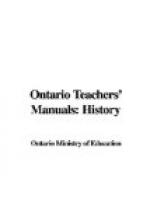Again, in the story of Madeleine de Vercheres, the narrative may proceed to the point where Madeleine has succeeded in securing the gates. She finds herself in a weak fort with few to help her, and outside a numerous band of Indians, who are kept at bay for a whole week, without even attempting their usual night attacks. How did she do it?
In the case of the U.E. Loyalists, the teacher may narrate the story to the point where the Loyalists, after the treaty was signed, saw that they must remove to Canada. The class must know where the Loyalist centres in the New England States were. Now, what routes would they be likely to take in going to Canada? With the map before them, the class can usually tell the next part of the story themselves.
Even if the pupil is not able to give the correct answer to the problem submitted, he is nevertheless having an opportunity to exercise his judgment, he can see wherein his judgment differs from that of the persons concerned, his interest in their actions is increased, and the whole story will be more deeply impressed on his memory.
HOW TO MAKE HISTORY REAL
The chief difficulty in teaching history is to give a meaning to the language of history. Much of the language is merely empty words. The Magna Charta and the Clergy Reserves mean just about as much to pupils as x does in algebra, and even when they give a definition or description of these terms, it usually amounts to saying that x equals y; the definition is just as vague as the original terms. The problem is to give the language more meaning, to ensure that the words give mental pictures and ideas; in short, to turn the abstract into concrete facts.
Children can make their own only such knowledge as their experience helps them to interpret. Their interests are in the present, and the past appeals to them just so far as they can see in it their own activities, thoughts, and feelings. The great aim of the teacher, then, should be to help pupils to translate the facts of history into terms of their own experiences; unless that is done, they are really not learning anything. Some of the ways in which this may be attempted are outlined below.
1. In the junior classes where the children are intensely interested in stories, the stress should be put on giving them interesting personal details about the famous people in history, details that they can understand with their limited experiences of life, and that will appeal to their emotions. These stories should be told to the pupils with such vividness and animation that they will struggle with Columbus against a mutinous crew, will help the early explorers to blaze their way through the dense forests, will toil with the pioneers in making homes for themselves in Canada, and will suffer with the missionaries in their hardships and perils.
For these pupils the oral method is the only one to use, for there is nothing that appeals to children more quickly and with more reality than what they hear from the teacher. The oral method should find a large place in the teaching of history in all the Forms. It may be added that the teachers who use this method will find history become a more real and interesting study to themselves.




